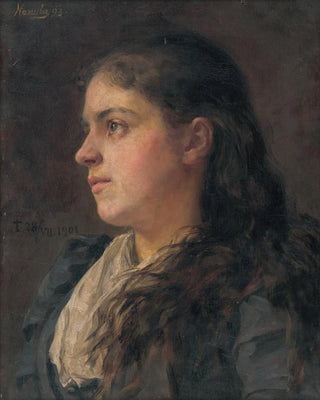Art print | Portrait of a woman - Jozef Hanula


View from behind

Frame (optional)
Portrait of a woman - Jozef Hanula – Captivating introduction
In the world of art, some works transcend time and space, capturing emotions and stories that resonate through the ages. The "Portrait of a woman" by Jozef Hanula is one of those creations that, through its depth and delicacy, invites the viewer to delve into the intimacy of its subject. This piece, both mysterious and evocative, transports us to a universe where each brushstroke seems to whisper forgotten secrets. Hanula, with his keen sense of observation and mastery of nuances, succeeds in immortalizing not only the appearance but also the essence of the woman he depicts. Far from being a simple portrait, this work is an invitation to contemplation and reflection.
Style and uniqueness of the work
Jozef Hanula's style is characterized by exceptional finesse and meticulous attention to detail. In "Portrait of a woman," he uses a soft and harmonious color palette, creating an atmosphere that is both serene and emotionally charged. Light plays a crucial role in this composition, highlighting the delicate features of the face while subtly shading certain areas. This duality between light and darkness gives the piece psychological depth, making the woman's face both accessible and enigmatic. The posture and expression of his model reflect introspection, gentleness, and inner strength that captivate the gaze. Every element, from clothing choices to hair care, contributes to creating a unique atmosphere, making this portrait a true ode to femininity.
The artist and his influence
Jozef Hanula, a Slovak artist, is recognized for his ability to capture the human soul in his works. Trained in academic traditions, he has evolved to develop a style that is uniquely his own, blending realism and impressionism. His work is marked by a particular sensitivity, demonstrating his respect for his models and his desire to portray them in all their complexity. Hanula was influenced by the great masters of painting, but he also managed to incorporate contemporary elements, thus creating a bridge between the

Matte finish

View from behind

Frame (optional)
Portrait of a woman - Jozef Hanula – Captivating introduction
In the world of art, some works transcend time and space, capturing emotions and stories that resonate through the ages. The "Portrait of a woman" by Jozef Hanula is one of those creations that, through its depth and delicacy, invites the viewer to delve into the intimacy of its subject. This piece, both mysterious and evocative, transports us to a universe where each brushstroke seems to whisper forgotten secrets. Hanula, with his keen sense of observation and mastery of nuances, succeeds in immortalizing not only the appearance but also the essence of the woman he depicts. Far from being a simple portrait, this work is an invitation to contemplation and reflection.
Style and uniqueness of the work
Jozef Hanula's style is characterized by exceptional finesse and meticulous attention to detail. In "Portrait of a woman," he uses a soft and harmonious color palette, creating an atmosphere that is both serene and emotionally charged. Light plays a crucial role in this composition, highlighting the delicate features of the face while subtly shading certain areas. This duality between light and darkness gives the piece psychological depth, making the woman's face both accessible and enigmatic. The posture and expression of his model reflect introspection, gentleness, and inner strength that captivate the gaze. Every element, from clothing choices to hair care, contributes to creating a unique atmosphere, making this portrait a true ode to femininity.
The artist and his influence
Jozef Hanula, a Slovak artist, is recognized for his ability to capture the human soul in his works. Trained in academic traditions, he has evolved to develop a style that is uniquely his own, blending realism and impressionism. His work is marked by a particular sensitivity, demonstrating his respect for his models and his desire to portray them in all their complexity. Hanula was influenced by the great masters of painting, but he also managed to incorporate contemporary elements, thus creating a bridge between the






